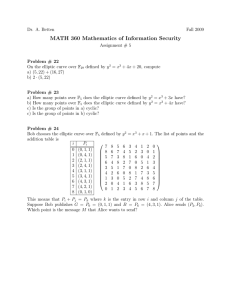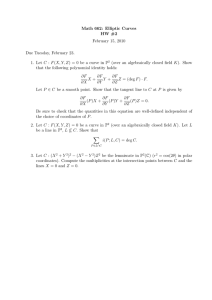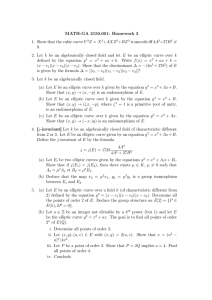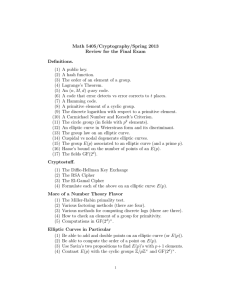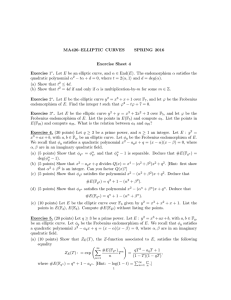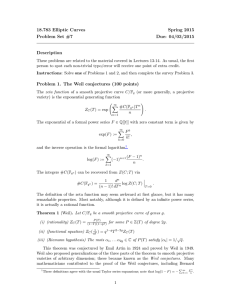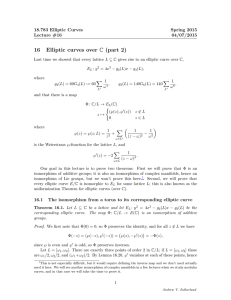MA426–ELLIPTIC CURVES SPRING 2016 Exercise Sheet 3
advertisement
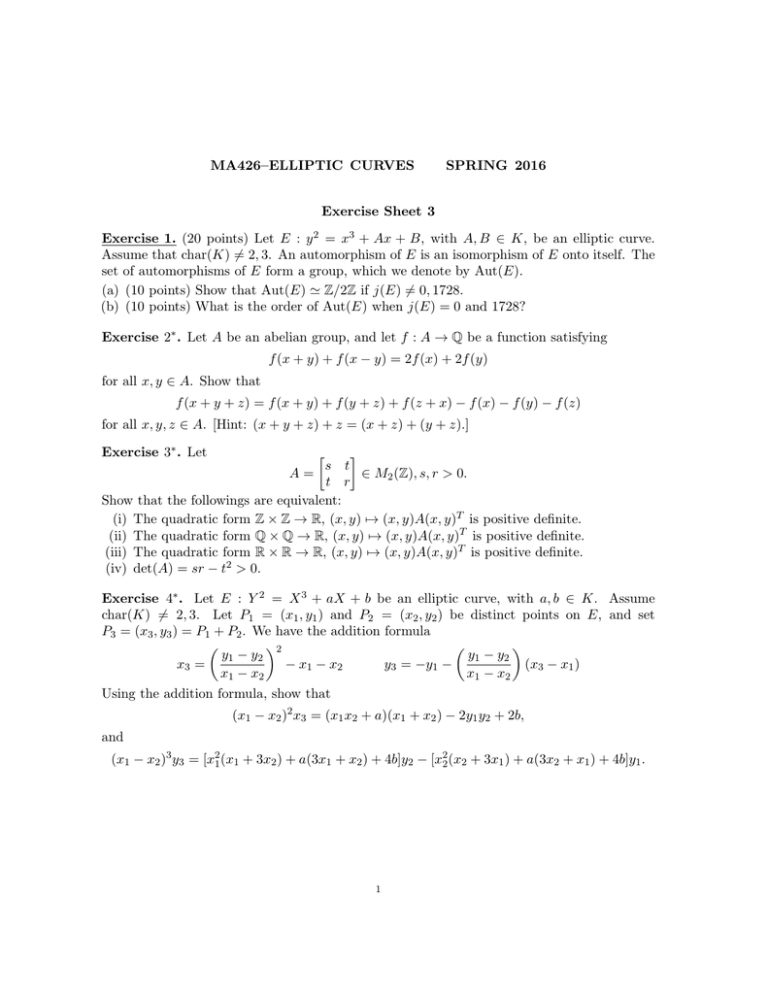
MA426–ELLIPTIC CURVES
SPRING 2016
Exercise Sheet 3
Exercise 1. (20 points) Let E : y 2 = x3 + Ax + B, with A, B ∈ K, be an elliptic curve.
Assume that char(K) 6= 2, 3. An automorphism of E is an isomorphism of E onto itself. The
set of automorphisms of E form a group, which we denote by Aut(E).
(a) (10 points) Show that Aut(E) ' Z/2Z if j(E) 6= 0, 1728.
(b) (10 points) What is the order of Aut(E) when j(E) = 0 and 1728?
Exercise 2∗ . Let A be an abelian group, and let f : A → Q be a function satisfying
f (x + y) + f (x − y) = 2f (x) + 2f (y)
for all x, y ∈ A. Show that
f (x + y + z) = f (x + y) + f (y + z) + f (z + x) − f (x) − f (y) − f (z)
for all x, y, z ∈ A. [Hint: (x + y + z) + z = (x + z) + (y + z).]
Exercise 3∗ . Let
s t
A=
∈ M2 (Z), s, r > 0.
t r
Show that the followings are equivalent:
(i) The quadratic form Z × Z → R, (x, y) 7→ (x, y)A(x, y)T is positive definite.
(ii) The quadratic form Q × Q → R, (x, y) 7→ (x, y)A(x, y)T is positive definite.
(iii) The quadratic form R × R → R, (x, y) 7→ (x, y)A(x, y)T is positive definite.
(iv) det(A) = sr − t2 > 0.
Exercise 4∗ . Let E : Y 2 = X 3 + aX + b be an elliptic curve, with a, b ∈ K. Assume
char(K) 6= 2, 3. Let P1 = (x1 , y1 ) and P2 = (x2 , y2 ) be distinct points on E, and set
P3 = (x3 , y3 ) = P1 + P2 . We have the addition formula
y1 − y2 2
y1 − y2
x3 =
− x1 − x2
y3 = −y1 −
(x3 − x1 )
x1 − x2
x1 − x2
Using the addition formula, show that
(x1 − x2 )2 x3 = (x1 x2 + a)(x1 + x2 ) − 2y1 y2 + 2b,
and
(x1 − x2 )3 y3 = [x21 (x1 + 3x2 ) + a(3x1 + x2 ) + 4b]y2 − [x22 (x2 + 3x1 ) + a(3x2 + x1 ) + 4b]y1 .
1
2
MA426–ELLIPTIC CURVES
SPRING 2016
Exercise 5. (20 points) Let L be a lattice in C such that iL = L. Let Gk (L) be the
corresponding Eisenstein series for k ∈ Z>0 and let ℘L (z) its Weierstrass ℘-function.
(a) (5 points) Prove that Gk (L) = 0 unless 4 divides k and show that ℘L (iz) = −℘L (z).
What is the equation of the elliptic curve whose complex points are isomorphic to C/L?
(b) (5 points) Prove that if L is any lattice closed under complex conjugation, and x ∈ R is
not in L, then ℘L (x) ∈ R.
(c) (10 points) Let L = µZ[i], where Z[i] = {n + mi : n, m ∈ Z} is the lattice of Gaussian
integers and µ is any positive real number. Using (a) and (b), find the zeros of ℘L and
then prove that g2 (L) = 60G4 (L) > 0.
Exercise 6. (30 points) Let E be an elliptic curve given by y 2 = x3 + Ax over Q. Let i be a
square root of −1 and let α be the automorphism of E given by α(x, y) = (−x, iy).
(a) (10 points) Compute deg(1 + α).
(b) (5 points) What is the kernel of 1 + α?
(c) (5 points) For integers a, b, let φa,b be the endomorphism [a]+[b]α. Show that deg(φa,b ) =
a2 + b2 for all a, b ∈ Z.
(d) (10 points) Show that for any a, b ∈ Z, there is an endomorphism ψa,b such that for all
P ∈ E(Q) we have
ψa,b (φa,b (P )) = φa,b (ψa,b (P )) = [a2 + b2 ]P.
Exercise 7. (30 points) Let p ≡ 1( mod 3) be a prime, and Fp the finite field with p elements.
Let E be the elliptic curve defined over Fp by the equation Y 2 = X 3 + B, B ∈ Fp .
(i) (10 points) Let ζ ∈ Fp be such that ζ 3 = 1 and ζ 6= 1. Define the map
α : E(Fp ) → E(Fp )
(x, y) 7→ (ζx, y).
Show that α is an endomorphism, and that α2 + α + 1 = 0.
(ii) (5 points) Consider the quadratic ring
Z[ζ] := {a + bζ : a, b ∈ Z} ⊂ C.
Define the map
θ : Z[ζ] → End(E)
m + nζ 7→ m + nα,
where m + nα = [m] + [n]α. Show that θ is a ring homomorphism.
(iii) (15 points) Show that deg(m + nα) = m2 − mn + n2 , for all m, n ∈ Z. Deduce that θ is
injective.
The exercises with
∗
are NOT for credit.
Due on 18/2/2016 before 2pm.
There is a dropbox set by the undergraduate office.



